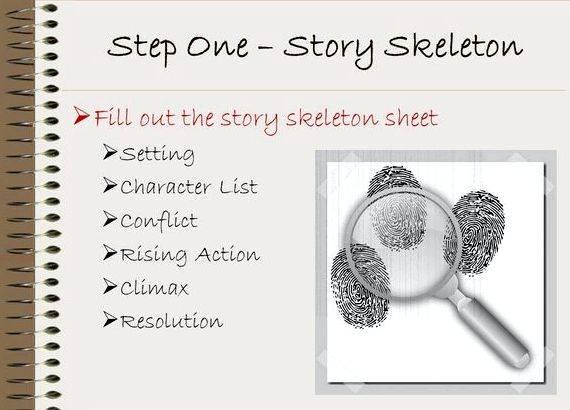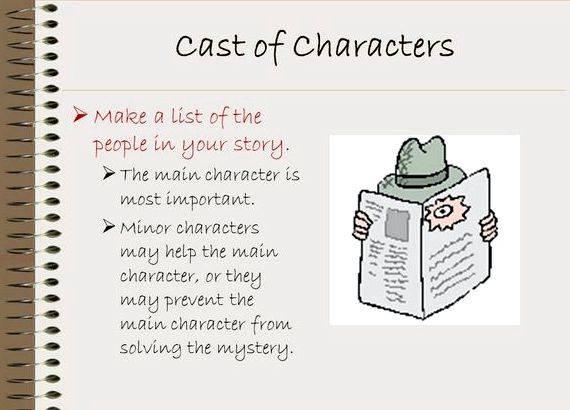

This mystery-writing lesson focuses on the structure of a short story and the elements of a mystery in particular. Students complete the entire writing process: prewriting, drafting, revising, editing, and publishing. Students demonstrate the ability to write in a different voice for a different audience by rewriting their own mystery stories as a news article. Students then work together to create a newsletter about all the students’ mysteries.
5. Use basic features of word processing, spreadsheets, databases, and presentation software.
6. Select specific digital tools for completing curriculum-related tasks.
2. Determine a theme or central idea of a text and analyze its development over the course of the text; provide an objective summary of the text. [RL.7.2]
3. Analyze how particular elements of a story or drama interact (e.g. how setting shapes the characters or plot). [RL.7.3]
21. Write informative or explanatory texts to examine a topic and convey ideas, concepts, and information through the selection, organization, and analysis of relevant content. [W.7.2]
22. Write narratives to develop real or imagined experiences or events using effective technique, relevant descriptive details, and well-structured event sequences. [W.7.3]
Primary Learning Objective(s):
Students will demonstrate mastery of the elements of a short story and the writing process by constructing a short story mystery. Students will apply writing mechanics. Students will write in different voices. Students will collaborate as a group to construct a newsletter.

Additional Learning Objective(s):
Students will develop critical thinking skills through the development of a mystery.
Approximate Duration of the Lesson:

Greater than 120 Minutes
Materials and Equipment:
Teacher-made slideshow presentation (see attached), students’ handouts–Mystery Story Skeleton and Newsletter Instructions (both attached), rubrics (attached)
Technology Resources Needed:
Computer with word processing and desktop publishing software, TV and scan converter or digital projector and screen for presentations
This writing lesson is one component of an interdisciplinary mystery unit. Other language arts activities include reading several mysteries (dramatizations) orally in class and reading a mystery novel while participating in literature circles.
1.)Introduce the assignment by showing students the teacher made slideshow to explain all steps in the mystery-writing project (see attachment, slides 1-7).
2.)Hand out the Mystery Skeleton Sheet (attached). Referring to the slideshow, explain how to fill in the skeleton. Allow students time to finish this step. Students may share the skeleton with classmates. Collect the skeleton to check for understanding of the parts of the mystery. Return skeletons prior to the next step (presentation attachment slides 8-16).
3.)Explain character webs. Model a character web based on a character from a previously read literature selection. Then make a character web together as a class on a made-up character. Assign character webs for each character on the student’s skeleton. Collect to check for understanding.
4.)Assign the writing of a rough draft. Allow students both in-class and out-of-class time to complete the rough draft.

5.)Have students work in peer groups to revise their stories. Teach or review elaboration techniques. Have students then work in peer groups to edit stories.
6.)Allow students time to complete final copies using word processing software. Stories might be compiled in a classroom book for sharing with other classes, teachers, or parents.
7.)Formally assess both the mystery story and the newsletter with the rubrics provided.
Attachments: **Some files will display in a new window. Others will prompt you to download.
The rubrics attached will be used for final assessment. Interim assessments are recommended to ensure that students are completing components of the assignment (such as finishing the skeleton, the character webs, the rough draft, and the revisions).
Illustrations of the writing might be required. Stronger writers will be able to create more in-depth characters and more complex plots.
Less proficient writers may benefit from working with peers, particularly on the planning phase with the skeleton sheet and on the revision work. One-on-one help from the teacher or a tutor might also be necessary for ESL students or very weak writers. Shorter stories with simpler plots could meet could meet the requirements for weaker writers.
Each area below is a direct link to general teaching strategies/classroom accommodations for students with identified learning and/or behavior problems such as: reading or math performance below grade level; test or classroom assignments/quizzes at a failing level; failure to complete assignments independently; difficulty with short-term memory, abstract concepts, staying on task, or following directions; poor peer interaction or temper tantrums, and other learning or behavior problems.
Previous answers to this question
This is a preview of an assignment submitted on our website by a student. If you need help with this question or any assignment help, click on the order button below and get started. We guarantee authentic, quality, 100% plagiarism free work or your money back.
 Get The Answer
Get The Answer